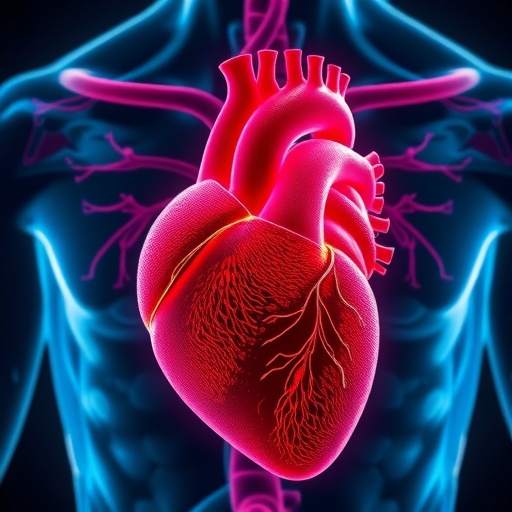Recent studies have illuminated the potential cardioprotective properties of ellagic acid, a naturally occurring polyphenol found in a variety of fruits and vegetables. An investigation spearheaded by a team of researchers has revealed how this compound can mitigate the adverse effects linked to adrenaline-induced toxicity. This research, poised to make waves in the fields of cardiology and pharmacology, delves into the molecular mechanisms that underscore the protective roles of ellagic acid.
Adrenaline, also known as epinephrine, is a hormone that plays a pivotal role in the body’s response mechanisms to stress, often referred to as the fight-or-flight response. However, while adrenaline can be beneficial in acute scenarios, excessive amounts can lead to oxidative stress and subsequent cardiotoxicity. The new findings suggest that ellagic acid can counteract these toxic effects by modulating critical signaling pathways.
At the core of the study is the analysis of the PI3K/AKT signaling pathway, which is essential for cellular survival and growth. Activation of PI3K/AKT has been shown to provide protective effects in cardiac cells by promoting cell survival and inhibiting apoptosis. The researchers demonstrated that treatment with ellagic acid led to significant activation of the PI3K/AKT pathway, suggesting that it may enhance the endurance of cardiac cells under stressful conditions induced by high levels of adrenaline.
Another essential mechanism explored in the study is related to the Keap1-NRF2 signaling axis, a crucial pathway involved in cellular defense against oxidative stress. Under normal circumstances, NRF2 (Nuclear factor erythroid 2-related factor 2) is kept in the cytoplasm by its inhibitor Keap1. However, when oxidative stress levels rise, NRF2 is released and translocates to the nucleus, where it initiates the expression of antioxidant genes. The research revealed that ellagic acid not only activates NRF2 but also reduces the interaction with Keap1, promoting a quicker and more robust antioxidant response.
The findings underscore the potential therapeutic roles that dietary components like ellagic acid may play in cardiovascular health. In a world where lifestyle diseases are on the rise, such natural compounds offer a glimmer of hope for those at risk of heart-related conditions. By incorporating ellagic acid into the diet, individuals may bolster their heart health while preventing damage from excessive adrenaline exposure.
This study sets the stage for further exploration into the clinical implications of ellagic acid. While the mechanisms uncovered in the research hold promise, translating these findings into practical treatments will require rigorous clinical trials. Investigating appropriate dosages, bioavailability, and long-term effects of ellagic acid will be essential steps in establishing its efficacy and safety in human populations.
Furthermore, the research opens up avenues for studying other natural compounds with similar protective effects on the heart. As the understanding of phytochemicals and their biological actions expands, there may be a treasure trove of potential heart health enhancers waiting to be discovered. This aligns with a growing trend in medicine to focus on preventive care and the role of nutrition in health maintenance.
The implications of this study are far-reaching. Beyond individual health, the research potentially informs public health initiatives aimed at reducing cardiovascular disease prevalence. By emphasizing the importance of dietary choices, health professionals can advocate for the inclusion of fruits and vegetables rich in ellagic acid, further promoting community health and well-being.
Additionally, the insights gleaned from this research have been met with enthusiasm in the scientific community. Experts predict that findings detailing the interactions between natural compounds and cellular mechanisms will generate interest in developing nutraceuticals that can achieve cardioprotective effects equivalent to pharmaceuticals without the associated side effects.
The involvement of ellagic acid in modulating stress-induced cellular responses encourages a reevaluation of conventional treatment strategies for adrenaline-related cardiovascular issues. By considering dietary interventions alongside traditional therapies, patients may find more holistic approaches to managing their health concerns.
In essence, this groundbreaking study serves as a landmark contribution to our understanding of how natural compounds can enhance cardiac protection against stressors. The potential applications for ellagic acid extend beyond the laboratory, paving the way for innovative dietary strategies that can combat heart disease in the modern era.
As we advance our knowledge of phytochemistry and the body’s response systems, we are likely to uncover more critical interactions that inform our approach to heart health. The future of cardiovascular care may very well lie not just in medications, but in a deeper understanding of nutrition and its role in maintaining our biological systems.
Ultimately, the discovery that ellagic acid can influence key signaling pathways presents an exciting frontier in scientific research, holding promise for both prevention and treatment strategies in cardiovascular health. It encourages a holistic view of medicine that integrates lifestyle, nutrition, and innovative science to tackle pressing health challenges in society.
Subject of Research: Ellagic acid and its cardioprotective effects against adrenaline-induced toxicity.
Article Title: Ellagic acid mediates cardioprotection against adrenaline-induced toxicity via PI3K/AKT and Keap1-NRF2 axes.
Article References:
Aldayel, T.S., Haleka, S.A.A., Ebaid, H.M. et al. Ellagic acid mediates cardioprotection against adrenaline-induced toxicity via PI3K/AKT and Keap1-NRF2 axes. Sci Rep 15, 36489 (2025). https://doi.org/10.1038/s41598-025-21317-7
Image Credits: AI Generated
DOI:
Keywords: Ellagic acid, cardioprotection, adrenaline toxicity, PI3K/AKT, Keap1-NRF2, oxidative stress, cardiovascular health.
Tags: adrenaline-induced toxicity mitigationantioxidants for cardiovascular protectioncellular survival and growth in cardiac cellsellagic acid cardioprotective propertiesellagic acid in fruits and vegetablesfight-or-flight response and heartmolecular mechanisms of ellagic acidnatural polyphenols in heart healthoxidative stress and cardiotoxicitypharmacological implications of ellagic acidPI3K/Akt signaling pathway activationstress response and heart health





